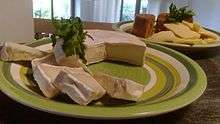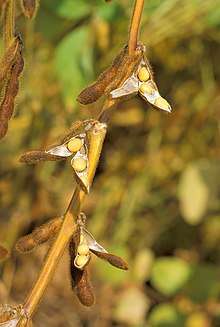Vegan cheese
Vegan cheese is a non-dairy or plant cheese analogue aimed at vegans and other people who want to avoid animal products, including those who are lactose-intolerant.[1] As with plant milk, vegan cheese can be made from seeds, such as sesame and sunflower; nuts, such as cashew,[2] pine nut, and almond;[3] and soybeans, peanuts, coconut oil, nutritional yeast, tapioca,[4] and rice, among other ingredients.
Vegan cheese is cholesterol-free and may be a good source of soy protein.[5] Several brands melt in the way dairy cheese does. Popular brands include Daiya, GoVeggie, Follow Your Heart, and Tofutti.
Non-dairy cheese became commercially available in the 1980s,[6] but at that time and into the 1990s, the vegan cheeses available weren’t as good quality as regular cheese having a waxy, chalky or plasticky texture[7]. In the early 1990s, a high-quality vegan cheese called Sheese was available in Scotland. In the United States, the only brand of vegan cheese available at the time was Soymage.[8] Since then, the variety and taste of vegan cheese have improved significantly.[6][8]
A difficult challenge for food scientists is creating vegan cheese that melts and stretches like real cheese. Dairy cheese, and many lactose-free cheese analogues, melt and stretch because of the protein casein, which is a milk protein and therefore not vegan, so food scientists use a "blend of gums, protein, solids and fats" to attempt to duplicate the mouthfeel and melt of real cheese.[9] A project called Real Vegan Cheese aims to solve this difficulty by making cheese with casein produced by yeast rather than by cows. This cheese would have real casein, but would be vegan because the casein would not be animal-derived.[10]
References
- ↑ Dixie Mahy, Miyoko Schinner, Artisan Vegan Cheese, Book Publishing Company, 2013, p. v.
- ↑ Stepkin, Kay (16 January 2013). "Vegan cheese replaces lingering brie craving: Vegan brie takes just minutes of actual work". Chicago Tribune. Archived from the original on 3 March 2018. Retrieved 3 March 2018.
- ↑ Buren, Alex Van (29 March 2018). "What Is Vegan Cheese Exactly—and Should You Be Eating It?". Health. Yahoo!. Archived from the original on 3 April 2018. Retrieved 3 April 2018.
Those looking to emulate the creamy texture and saltiness of real cheese tend to find themselves reaching for cashews, both at restaurants and at home. [...] But several other nuts can be transformed into vegan 'cheese'—what Keenan calls 'nutcheese'—such as almonds and pine nuts, among others.
- ↑ Moreau, Elise. "What in the World is Vegan Cheese, Anyway? Can it Actually Replace 'Real' Cheese?". Foodie Buzz. Organic Authority. Archived from the original on 3 April 2018. Retrieved 3 April 2018.
Depending on the brand and recipe that's used, vegan cheese can be made from soy protein (used in shiny, slick, rubbery varieties), solidified vegetable oil (like coconut, palm, or safflower) nutritional yeast, thickening agar flakes, nuts (including cashews, macadamias, and almonds), tapioca flour, natural enzymes, vegetable glycerin, assorted bacterial cultures, arrowroot, and even pea protein.
- ↑ Nutritional value of Toffuti mozzarella. United States Department of Agriculture, Agricultural Research Service: USDA Branded Food Products Database. Accessed 02/16/2018
- 1 2 "The Evolution of Vegan Cheese". Fresh n' Lean. 22 June 2015. Archived from the original on 3 April 2018. Retrieved 3 April 2018.
- ↑ "The Evolution of Vegan Cheese - Fresh n' Lean". Organic Meal Delivery Service | Healthy Diet | Fresh n' Lean. 2015-06-22. Retrieved 2018-03-02.
- 1 2 Winograd, Jennifer; Winograd, Nathan (15 August 2011). "A Guide to Vegan Cheese". All American Vegan. Archived from the original on 3 April 2018. Retrieved 3 April 2018.
- ↑ Estabrook, Rachel (30 April 2012). "Cracking The Code: Making Vegan Cheese Taste Cheesier". The Salt. NPR. Archived from the original on 3 April 2018. Retrieved 3 April 2018.
But to make a true vegan cheese substitute, you can't use casein. So [Jonathan] Gordon's latest challenge has been to make a cheese that is completely free of animal byproducts but still retains the properties we love about cheese. 'The skill of the formulator is to use exactly the right amounts and blend of gums, protein, solids and fats to get a desirable, cheese-like bite and mouth feel while achieving a realistic melt (this is very difficult),' he tells The Salt. Those gums replace the casein, working as 'emulsifiers'and 'stabilizers' to hold the other ingredients together, according to Crowe. (The other ingredients include a protein base like soy or rice, water, oil, starches, flavors and colors.)
- ↑ Messina, Ginny (28 September 2014). "Real Vegan Cheese and Real Nutrition Science". The Vegan RD. Archived from the original on 3 April 2018. Retrieved 3 April 2018.
One of those innovations in the works is for Real Vegan Cheese, using the milk protein casein but without the input of a cow. It boggles the mind (or at least my mind) but biotech researchers are working on it right now in labs in Oakland and Sunnyvale, California.
Collection of primary sources
- Shurtleff, W.; Aoyagi, A. (2013). History of Cheese, Cream Cheese and Sour Cream Alternatives (With or Without Soy) (1896-2013):: Extensively Annotated Bibliography and Sourcebook. Soyinfo Center. ISBN 978-1-928914-61-7.

.jpg)
.jpg)

